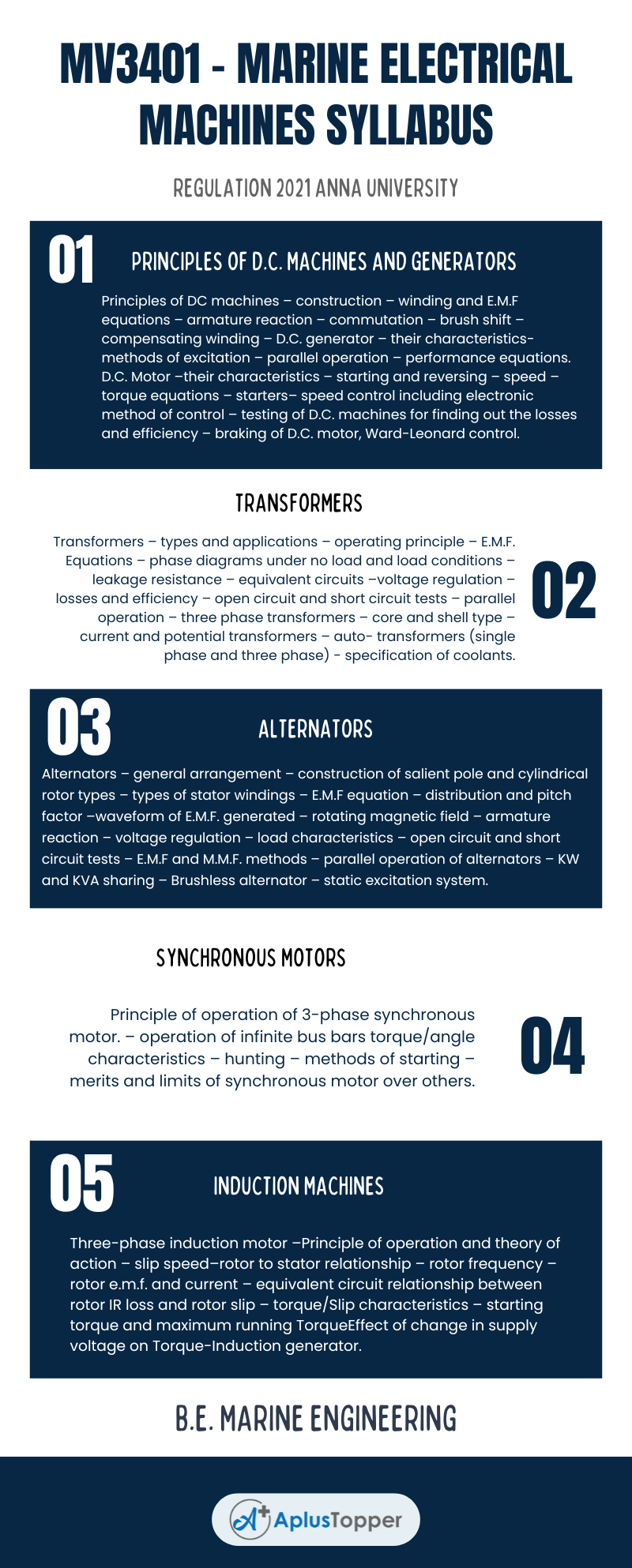Marine Electrical Machines is a dynamic subject that continuously shifts from one perspective to another. However, the technicality is the same even if the theories and perspectives vary. Hence to gain knowledge in this subject you must be equipped with more vicious on the syllabus.
In this article, we tried to provide the required syllabus of the MV3401 Marine Electrical Machines subject to gain command of the subject matter. By the end of the course, you will be trained and guided with useful knowledge regarding technical english, which plays a major role in understanding the core of this B.E Marine Engineering semester IV related to Affiliated institutions awarded by Anna University course. Hope this information is useful. Kindly share it with your friends. Comment below if you have queries regarding the syllabus.
If you want to know more about the syllabus of B.E. Marine Engineering connected to an affiliated institution’s four-year undergraduate degree program. We provide you with a detailed Year-wise, semester-wise, and Subject-wise syllabus in the following link B.E. Marine Engineering Syllabus Regulation 2021 Anna University.
Aim Of Concept:
- To expose the students to the Electrical equipment’s fitted on boards ships, the concepts of electrical measurements, and electrical distribution systems.
- To make the students to understand the concepts of Electricity production,
- To impart knowledge on measurements, cable faults and AC Machines used in Marine Engineering.
- To understand Principles of operation and construction details of synchronous motors, induction machines
- To impart knowledge on Speed control and trouble shooting in induction machines.
MV3401 – Marine Electrical Machines Syllabus
Unit I: Principles Of D.C. Machines And Generators
Principles of DC machines – construction – winding and E.M.F equations – armature reaction – commutation – brush shift – compensating winding – D.C. generator – their characteristics- methods of excitation – parallel operation – performance equations. D.C. Motor –their characteristics – starting and reversing – speed – torque equations – starters– speed control including electronic method of control – testing of D.C. machines for finding out the losses and efficiency – braking of D.C. motor, Ward-Leonard control.
Unit II: Transformers
Transformers – types and applications – operating principle – E.M.F. Equations – phase diagrams under no load and load conditions – leakage resistance – equivalent circuits –voltage regulation – losses and efficiency – open circuit and short circuit tests – parallel operation – three phase transformers – core and shell type – current and potential transformers – auto- transformers (single phase and three phase) – specification of coolants.
Unit III: Alternators
Alternators – general arrangement – construction of salient pole and cylindrical rotor types – types of stator windings – E.M.F equation – distribution and pitch factor –waveform of E.M.F. generated – rotating magnetic field – armature reaction – voltage regulation – load characteristics – open circuit and short circuit tests – E.M.F and M.M.F. methods – parallel operation of alternators – KW and KVA sharing – Brushless alternator – static excitation system.
Unit IV: Synchronous Motors
Principle of operation of 3-phase synchronous motor. – operation of infinite bus bars torque/angle characteristics – hunting – methods of starting – merits and limits of synchronous motor over others.

Unit V: Induction Machines
Three-phase induction motor –Principle of operation and theory of action – slip speed–rotor to stator relationship – rotor frequency – rotor e.m.f. and current – equivalent circuit relationship between rotor IR loss and rotor slip – torque/Slip characteristics – starting torque and maximum running TorqueEffect of change in supply voltage on Torque-Induction generator.
Text Books:
- Edmund G R, Kraallavers, “Advanced Electo-technology For Marine Engineers”, 2nd Ed. Reeds Vol 07, Adlard Coles Nautical, London, 2010
- W. Laws, “Electricity Applied To Marine Engineering”, 4th edition, The Institute Of Marine Engineers, London, 1998.
- IHerman, “Electrical Transformers and Rotating Machines”, 3rd Ed. Cengage, First Indian Reprint 2012 ( Yesdee Publishings Pvt. Ltd.),
- Edmund GR Kraal, Stanley Buyers, Christopher Lavers, “Basic electro-technology for marine engineers”, 4th Ed. Reeds Vol 06,2013
- Hughes Edward, “Electrical technology”, 2nd edition, “ELBS with DP Publications”, USA, 1996.
- I.J Nagrath and D.P Kothari, “Basic Electrical Engineering”, 2nd Edition, McGraw Hill Publishing Co., Ltd., New Delhi, 2002.
References:
- Uppal S.L., “Electrical Power”, 13th Edition, Khanna publishers, Mumbai, 2002.
- Berde M.S.,” Electric Motor Drives”, 1st Edition, Khanna Publishers, Mumbai, 1995.
- W. Laws, “Electricity Applied To Marine Engineering”, 4th edition, The Institute Of Marine Engineers, London, 1998.
- Gorti Ramamurthi, “Handbook of Electrical Power Distribution”, 2nd Ed.Universities Press, 2009
Related Posts On Semester – IV:
- MV3402 – Marine Refrigeration and Air Conditioning
- MV3403 – Ship’s Fire Prevention and Control
- MV3405 – Marine Diesel Engines
- MV3406 – Marine Boilers and Steam Engineering
- GE3451 – Environmental Sciences and Sustainability
Must Read For More:
